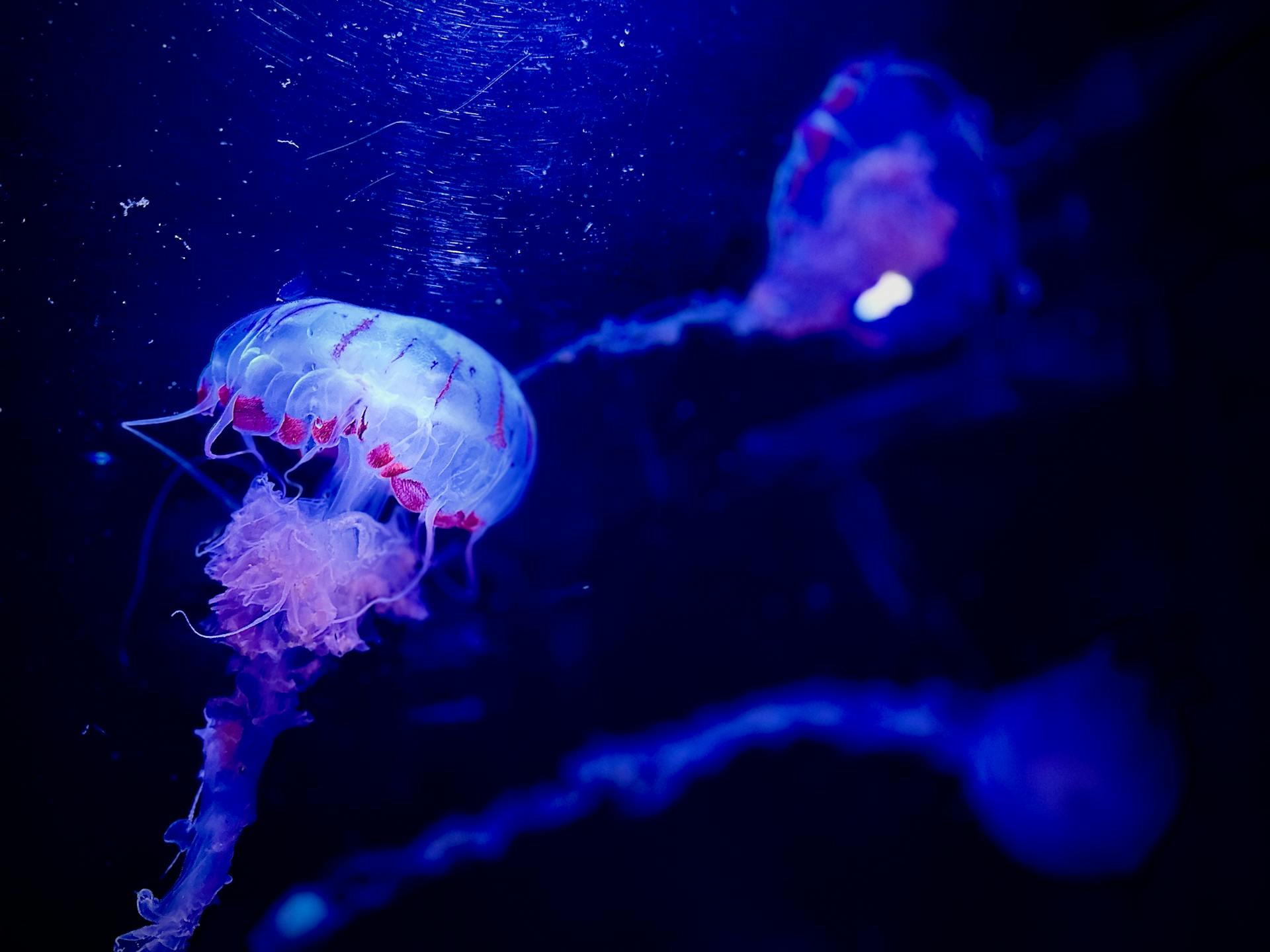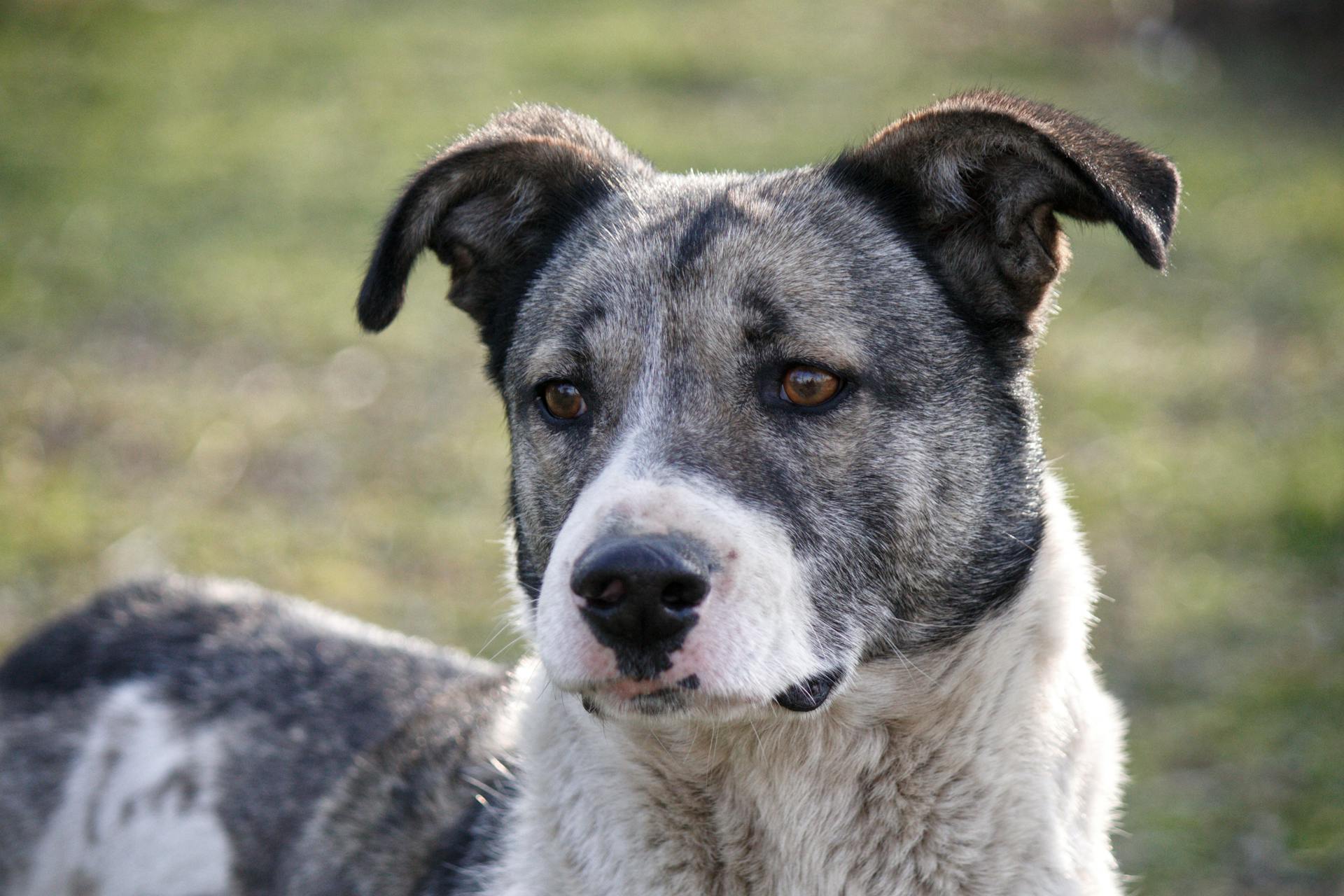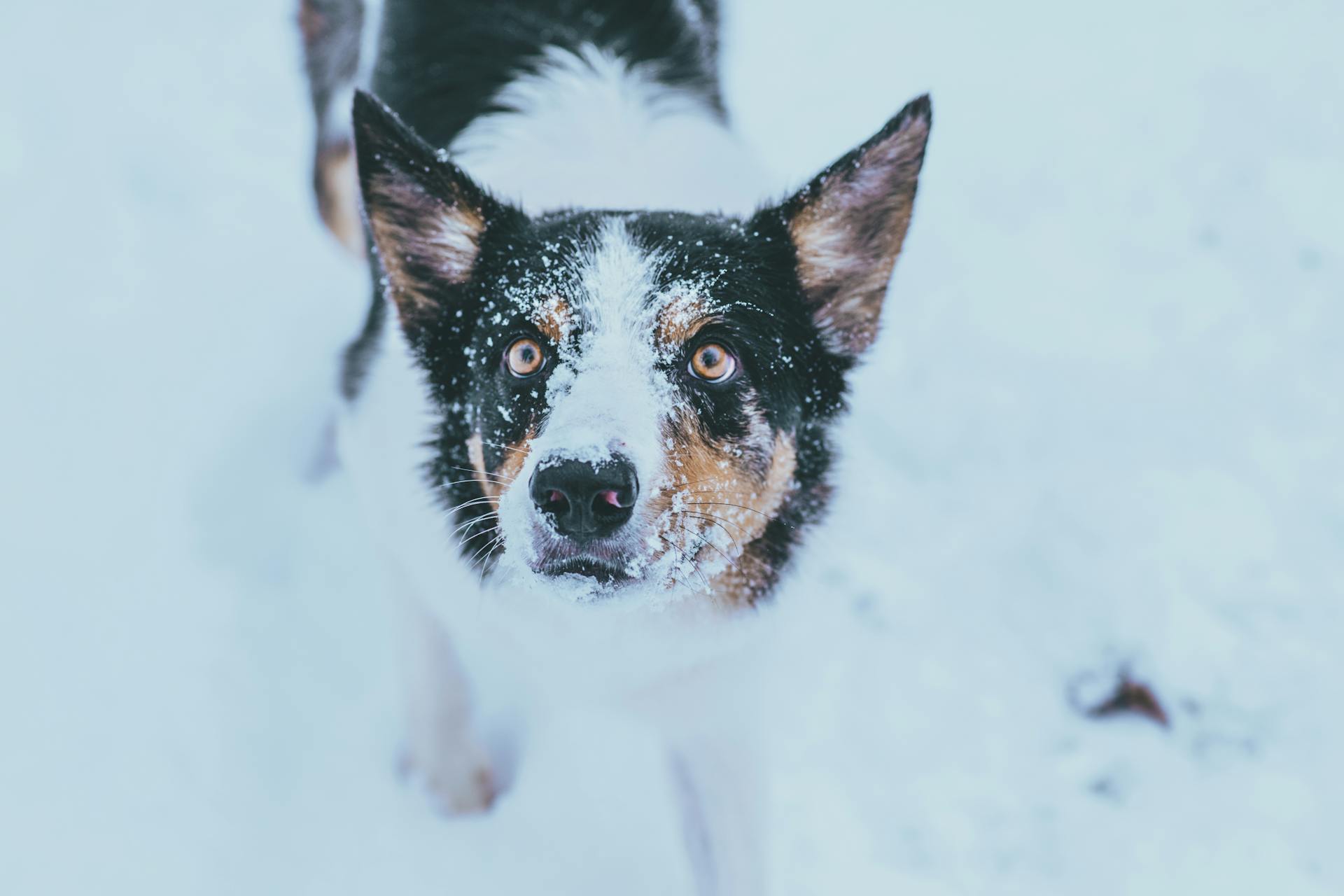
The Blue Heeler is a popular breed for many reasons, but like any dog, it's essential to consider both the pros and cons before deciding to bring one home. They are highly intelligent and energetic dogs that thrive on physical and mental stimulation.
Blue Heelers are known for their strong herding instincts, which can sometimes be misinterpreted as aggression. They require regular exercise and training to keep them happy and healthy.
One of the most significant pros of owning a Blue Heeler is their loyalty and affection towards their family. They make great companions and are often described as "velcro dogs" due to their tendency to stick close by.
However, their high energy levels and strong herding instincts can also be a challenge for inexperienced dog owners. Regular training and exercise can help mitigate these issues, but it's essential to be aware of them before bringing a Blue Heeler into your home.
For another approach, see: Blue Heeler Intelligence
Characteristics and Temperament
Blue heelers are known as "shadow dogs" because they become intensely devoted to their owners and dislike being separated from them.
They are extremely active dogs that will happily become your next running or hiking buddy. Their distinct blue or red coat is a trademark of the breed, but surprisingly, blue heeler puppies are born with white fur.
Blue heelers are generally cautious around strangers and need to be well-socialized to get along well with other household dogs and dog-friendly cats.
Their high energy level requires regular exercise, and they need daily opportunities to exercise their body and brain.
Here are some key characteristics of blue heelers:
Blue heelers take time to warm up to new people due to their protective and cautious nature, so it's essential to introduce them slowly and carefully.
They are medium-sized dogs that can weigh anywhere from 35 to 49 pounds and live between 12 and 16 years with proper care.
Blue heelers are not apartment dogs and need a lot of space and time focused on them, making them a great fit for active families or individuals.
Recommended read: Red Blue Heeler Mix Dogs
History and Purpose
The Blue Heeler's history is a fascinating one, dating back to the 19th century when Australian settlers bred them to help with ranching in the Australian grasslands.
They were developed by crossing dogs brought from England with the native Australian dingo, creating a strong and tough canine to handle the harsh climate.
In 1980, the Australian Cattle Dog, also known as the Blue Heeler, was accepted for registration by the American Kennel Club.
Their original purpose was to herd cattle in the Australian outback, not to hunt, as their unique appearance might suggest.
The breed was specifically developed to be a hardworking herding dog, suited to the Australian environment.
The Blue Heeler's genetic makeup includes not only dingo blood but also other breeds such as the Blue Smooth Highland Collie, Bull Terrier, Dalmatian, and black and tan Kelpie.
The American Kennel Club recognized the breed in 1980, and it was later moved to the Herding Group in 1983.
Curious to learn more? Check out: Blue Heeler History
Care and Maintenance
Blue heelers are relatively low maintenance when it comes to grooming, requiring only regular nail clipping, teeth brushing, and bathing. They don't usually need any special grooming beyond that.
Their two-layered coats do need extra attention during times of the year when they shed excessively, such as in the spring. During this time, it's essential to brush your blue heeler frequently to remove the hair.
Blue heelers require a lot of physical and mental stimulation, which can be achieved through daily walks, hikes, or swims, and they love living in homes with a fenced yard or a safe property to run in. They can become bored and destructive if left alone for long periods.
Here are some key grooming tasks to remember:
They also need regular exercise to stay happy and healthy, and they're active dogs that don't need a special diet beyond good quality dog food.
Care
Blue Heelers and Texas Heelers are high-energy breeds that require regular exercise to stay happy and healthy. They need a job or activity that gives them a physical and mental outlet, such as running, agility training, or farm work.

To provide the necessary exercise, consider enrolling your dog in daily sports or activities that you can participate in together, like hiking or swimming. This will not only burn off energy but also strengthen your bond with your dog.
A fenced yard or safe property to run in is essential for these breeds, as they love to live in homes with space to move around. However, be aware that they don't like to be left alone for long periods, especially in small spaces.
To keep your Blue Heeler or Texas Heeler clean, bathe them as necessary, trim their nails once a month, brush their teeth, and clean their ears on occasion. Their two-layered coats need extra attention during times of heavy shedding, such as spring, when they shed their winter coat.
Here are some key grooming tasks to remember:
- Bathe as necessary
- Trim nails once a month
- Brush teeth regularly
- Clean ears on occasion
- Brush coat frequently during heavy shedding seasons
Blue Heelers and Texas Heelers are generally low maintenance when it comes to grooming, but they do shed heavily in the spring. Be prepared for extra brushing during this time to remove loose hair.
In terms of diet, these breeds don't require a special diet beyond good quality dog food that's high in calories to sustain their active lifestyle.
Mix Care Requirements

Blue Heeler Golden Retriever mixes are high-energy dogs that require a lot of exercise to stay happy and healthy. They need daily walks, playtime, and mental stimulation to prevent boredom and excess energy.
These dogs love living in homes with a fenced yard or a safe property to run in. If they don't get an outlet for their energy, they can become bored and destructive.
A daily 10-minute walk is not enough for a Texas Heeler; they need a home where they can work or participate in daily sports like running, agility, and obedience training.
Their grooming needs are relatively low maintenance, requiring a once-a-week brushing but may need extra attention twice a year when the undercoat is shed.
To prevent chewing habits, it's essential to provide appropriate chew toys, especially during teething.
Here are some exercise requirements for Blue Heeler Golden Retriever mixes:
They need a home where they can go wherever you're going, and they can be wary of strangers if not properly socialized.
Exercise and Activity
Blue Heelers are high-energy dogs that require regular exercise to stay happy and healthy. They need at least a 30-minute walk, opportunities to run around, and an outlet for their herding instincts.
A variety of puzzles, chews, and tug toys can help keep your dog satisfied. You can keep your dog entertained with a treat-dispensing puzzle or a rubber toy filled with peanut butter or another treat.
For a 6-month-old Blue Heeler, the maximum exercise time should be 30 minutes, twice a day. This is crucial to prevent joint damage and support their growing bodies.
Blue Heelers are intelligent dogs that require activities that stimulate them physically and mentally. Activities like retrieving and tracking will maintain their focus and quick responses. Without things to do, your pup may get bored and misbehave.
Here are some fun activities for your Blue Heeler:
- Agility training
- Obedience training
- Herding trials
- Flyball
- Farm work
- Disc dog
- Fetch
- Running
- Hiking
- Camping
Do They Like Water?
Blue Heelers are natural athletes, and they love to burn off energy. They can run for hours, making them perfect companions for long hikes or jogs.
One of the best ways to keep your Blue Heeler happy and healthy is to get them in the water. All dogs can swim, and Blue Heelers are no exception. They may not have been bred for water work, but they can still learn to love it.
If introduced at an early age, Blue Heelers can learn to swim and even become quite proficient. This can be a great way to provide them with exercise and mental stimulation.
Fun Activities
Exercise and activity are crucial for a Blue Heeler's life, and they need regular physical and mental stimulation each day.
A 30-minute walk is a good starting point, but they also need opportunities to run around and an outlet for their herding instincts. You can keep your dog entertained with a treat-dispensing puzzle or a rubber toy filled with peanut butter or another treat.
As a Blue Heeler owner, you'll want to provide activities that stimulate them physically and mentally. This can include retrieving and tracking, which will maintain their focus and quick responses.
Australian Cattle Dogs, the breed from which Blue Heelers descend, require lots of exercise to keep them happy and healthy. They don't tire easily and are agile, making them well-suited for herding and other high-energy activities.
Here are some fun activities you can try with your Blue Heeler:
- Agility training
- Obedience training
- Herding trials
- Flyball
- Farm work
- Disc dog
- Fetch
- Running
- Hiking
- Camping
Remember, it's essential to not over-exercise your Blue Heeler at a young age, as this can damage their joints and isn't good for their growing bodies. For example, a 6-month-old Blue Heeler should have at most 30 minutes of exercise morning and evening.
Behavior and Training
Blue heelers are highly trainable due to their intelligence and energetic nature, making them excel in canine sports like agility and herding competitions.
Early socialization and training are crucial to prevent unwanted behaviors, such as nipping at kids or playing rough with other animals.
They are also eager to please, making them highly trainable, especially with positive reinforcement methods and consistency.
These dogs have a loyal personality and can be protective of their family and toys, but with early socialization, you can reduce their wariness towards strangers.
Without proper companionship and mental stimulation, blue heelers can become bored and develop behavior issues like excessive barking and separation anxiety.
To prevent this, it's essential to provide them with physical and mental exercise through consistent positive training that uses rewards instead of punishment.
Texas Heelers, a type of blue heeler, also require early socialization and consistent training to harness their intelligence and obedience.
Their critical development period from birth to 16 weeks is crucial for learning how to interact with humans and other animals, so talk to your breeder about their socialization approach.
On a similar theme: Training Australian Cattle Dog
Health and Nutrition
Blue heelers require proper nutrition to keep up with their active lifestyles. A balanced diet of commercial dog food is usually sufficient for companion blue heelers, but working dogs may benefit from performance diets.
Glucosamine and chondroitin can help promote healthy joints in blue heelers. Adding a joint supplement to their diet can be especially helpful for dogs with hip or elbow dysplasia.
Some health issues to be aware of in blue heelers include inherited deafness, portosystemic shunt, PRA, lens luxation, hip and elbow dysplasia, and osteochondritis dissecans.
Common Health Problems
Blue Heelers are generally considered healthy dogs, but like all breeds, they can be prone to certain health issues. One of the most common problems is joint-related, particularly cruciate ligament tears, so keep an eye out for any signs of limping or pain.
Canine hip dysplasia is another concern, which can cause limping, a "bunny hopping" gait, and stiffness. Progressive retinal atrophy is also a possibility, leading to impaired vision and enlarged pupils, especially in low light. This condition is painless but can result in complete blindness.
Deafness is a genetic predisposition that can be inherited in Blue Heelers. Signs of deafness include a lack of responsiveness to sound, jumpiness, and unusual barking fits.
Here are some common health issues that can affect Blue Heelers:
Lifespan
The Blue Heeler's lifespan is a promising 12-16 years, with a study in 2004 showing a mean age of twelve years for eleven deceased dogs.
This relatively long lifespan is likely due to the breed's sound conformation.
The oldest dog in this study lived to be sixteen years old, a testament to the breed's potential for longevity.
If you're a Blue Heeler owner, you can hope to have your furry friend by your side for a decade or more.
On a similar theme: Pros and Cons of Boxer Dogs
Nutritional Tips
Blue heelers are active dogs that require proper nutrition to keep up with their lifestyles. A balanced commercial dog food diet is usually sufficient for companion dogs.
If your blue heeler is a true working dog or spends hours sprinting, a performance diet may be beneficial to meet their specific needs.
As blue heelers age, their dietary needs may change, and switching to a canned food diet or soaking their kibble can be easier on their teeth.
Consider reading: Pros and Cons of Maltese Dogs
Adding a joint supplement containing glucosamine and chondroitin can help promote healthy joints in blue heelers, especially those with hip or elbow dysplasia or arthritis.
A complete and balanced diet of dog food approved by the AAFCO is usually sufficient for Texas Heelers, but nutritional supplements or prescription diets may be needed to treat certain health conditions.
Giving your pup a joint supplement, such as one containing glucosamine and chondroitin, can be very helpful for those with joint issues or arthritis, so it's best to talk to your veterinarian before adding anything new to their diet.
Frequently Asked Questions
Is a blue heeler a good house dog?
Blue Heelers can make great house dogs for families, but they may require socialization to get along with strangers and other pets. With proper training and socialization, they can thrive in a household environment.
Do Blue Heelers shed a lot?
Blue Heelers have a thick double-coat that sheds heavily twice a year, requiring regular grooming. They typically don't need frequent bathing due to their low-maintenance coat.
What are the bad habits of Australian Cattle Dogs?
Australian Cattle Dogs can be aggressive to other dogs and may develop bad habits like chasing cars or smaller animals due to their strong herding instinct. They may also try to herd smaller children, making them a challenging breed to manage.
Featured Images: pexels.com


